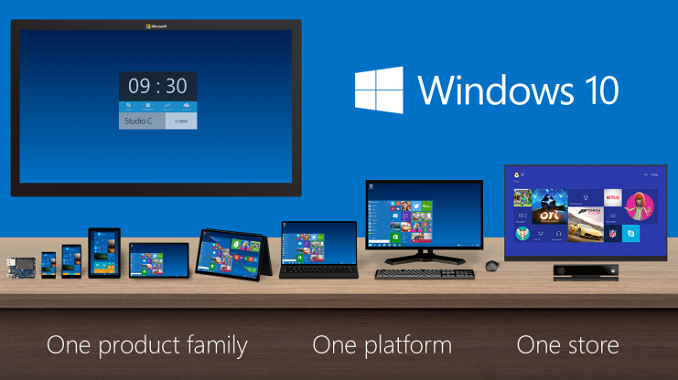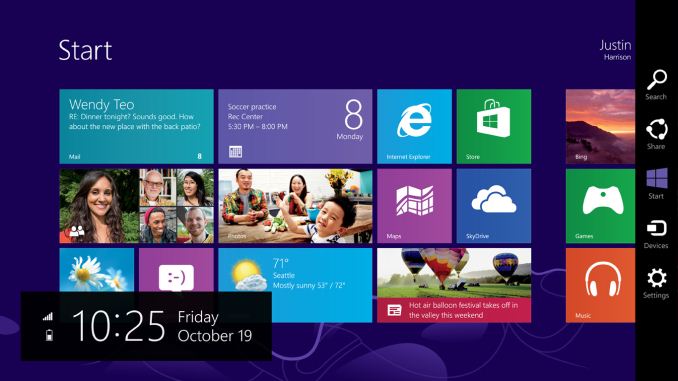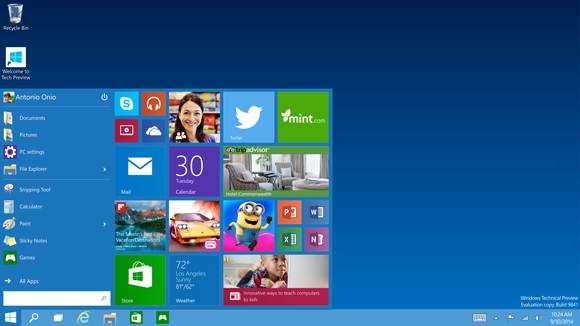Windows 10 Technical Preview First Impressions: The Return Of The Desktop
by Brett Howse on November 13, 2014 8:00 AM EST- Posted in
- Software
- Microsoft
- Windows 10

I’ve said this before, and I will reiterate it now. Windows 8, in general, is not perceived in a positive light. Not necessarily because of the lack of features, or even due to the touch first interface, but because from the start people did not buy into the paradigm. We can argue over why that was, and the specifics are likely different for every individual. But a big part of that was that Windows, which has had a familiar interface since Windows 95, had changed dramatically in look, feel, and general use. The traditional mouse and keyboard PC and notebook is a big part of the Windows user base, and especially at the beginning, Windows 8 did not cater to that crowd. While there were certainly improvements to the desktop, it was not enough to overcome the negative feelings of many users in regards to being productive on their PC. I say this as a fan of Windows 8.1, and I say this despite the positive review from this site. Windows 8 was an OS that worked, but had a steep learning curve that many people did not want to bother learning.
One of the biggest issues facing Windows 8 was just how much people liked Windows 7. Windows 7 was seen as the savior to Vista, and fixed many of its issues. But a lot of the initial problems with Vista were due to a major change in the driver model as well as the security model, which caused a lot of compatibility issues with older programs which expected administrator rights, as well as many hardware devices needed driver updates. With Windows 7, all of those changes were in the rear view mirror, allowing 7 to be a tweak of the overall UI and functionality rather than a rebuild of the OS from the ground up. With Windows 8, the move to touch first caused another dramatic upheaval. This time, rather than incompatible programs and hardware, we got a new Start Screen, a new runtime in WinRT, and a new app model with the Windows Store. For reasons that will never be made clear, the familiar start button was even removed, with the designers relying on hidden functions such as the hot corners to navigate around the OS with a mouse and keyboard. Luckily this change was reversed for Windows 8.1, with the start button returning, even if it still opened the Start Screen. With the Windows 8.1 Update, the system was made much more usable for a mouse and keyboard with the return of the menu bar to close apps, rather than dragging them down off the screen, and several other changes as well which brought the balance back somewhat to cover both touch interfaces as well as the mouse and keyboard.
 Windows 8 at launch in October 2012
Windows 8 at launch in October 2012
With Windows 8, Microsoft tried out an operating system which would work with a single interface across a breadth of hardware, from small form factor tablets, up to 30” monitor desktops. While they certainly succeeded in creating an interface that worked across all of those platforms, it was not ideally suited to any of them. With the tablet mode, the new Start Screen worked very well, and the charms menu and app switcher were fairly easy to use. But many of the settings and programs would be on the desktop, where touch only worked sparingly. Some desktop applications, such as Office, were created with a touch mode to increase the size of the onscreen elements, but overall the experience was subpar. Similarly, on the desktop, the touch interfaces were not ideal, and the hot corners certainly had issues especially on multi-monitor systems.
Windows 10 Technical Preview at launch
But now we come to Windows 10. Windows 10 is ditching the “One Interface to Rule them All” mentality, and moving to a more user friendly model of a single store across all platforms, and multiple interfaces to the same OS depending on the current usage model. We have not seen all of this in practice as of yet in the Technical Preview, but Microsoft has demonstrated their solution to this change in input mode with a feature they are calling Continuum.
The goal is that those that are on a keyboard and mouse based system will have the traditional start menu and desktop, with apps in windows, but if you are on a touch based device, or if you go on a 2-in-1 from keyboard to touch, the system will switch to the Windows 8 style start screen with full screen apps.
One of the keys to having this experience is an app model that allows a developer to target this different user interface paradigms. Microsoft’s solution to this is Universal Apps.











198 Comments
View All Comments
Scholzpdx - Thursday, November 13, 2014 - link
Looks decent. As it stands though, you're going to need something worth $100 for me to leave Windows 7.bgood2 - Thursday, November 13, 2014 - link
What about what I call "feature hokey pokey"? You put the feature in, you take the feature out, you put the feature in, and the users scream and shout?By that I mean things like System images, libraries, offline folders, Windows Experience Index etc. So many "gee whiz" features get thrown in for a version or two and then quietly disappear. Some return, others never do. Just about the time you get users accustomed to "Libraries", they're "deprecated". I can no longer depend that a new feature will remain in the OS long enough for my users to get comfortable with it.
Oh, and while I'm on my soapbox, it's ridiculous how often Windows Update *itself* has problems and stops working. WTH is *that* about?
kamm2 - Thursday, November 13, 2014 - link
WTH indeed! I've lost track of how many times I've had to help someone with Windows Update problems. And I don't even know that many people using Windows 8. Computers right out of the box have problems. Computers that have been working fine suddenly stop downloading updates. C'mon Microsoft, fix it once and for all.GatesDA - Thursday, November 13, 2014 - link
Good news: An overhaul of the update system is actually one of Win10's under-the-covers improvements.damianrobertjones - Thursday, November 13, 2014 - link
None of my own computers has failed with Windows Update and neither has any within this business (WSUS). Home users... who knows. Usually the time is wrongLerianis - Friday, November 28, 2014 - link
Actually, the usual issues for home owners when they cannot get updates is because they have been compromised, i.e. there is a virus on their computer. I personally found 4 not-very-well-known viruses on my relative's one computer they had been using for nearly a year now.They were VERY hard to track down because they did not disable Windows Defender, they did not disable Windows Update, etc.
They were 'stealthed' for the most part and only Hitman Pro x64 (shameless plug of that product) found the viruses in question.
jabber - Friday, November 14, 2014 - link
Windows 8 update feature is pretty poor. It was pretty solid in XP/Vista and 7 but its a lottery if it works in 8/8.1.I personally love the update bug that shows it downloading at 0% for an hour then switches to 99% and starts installing.
Plus new builds (service packs) as whole new installs that put all the apps crap back in are lovely.
ryrynz - Tuesday, November 18, 2014 - link
Agree this piss poor % updating is a major pain in the arse. Right up there with 100% for minutes.. No clue.Lerianis - Sunday, November 30, 2014 - link
You kidding? I've very very rarely had an update fail on Windows 8/8.1 and when I did, the next time I tried installing it the update installed correctly.Making me think that the issue was that "It was doing an automatic update at the same time I was trying to do a manual update!"
Lerianis - Friday, November 28, 2014 - link
Good news: Stop blaming machines getting viruses and other things on them on Microsoft. That is not the purview of Microsoft, kamm2, and all those issues you describe come from that, except the "Computers right out of the box have problems!"That last thing I have NEVER seen, where a computer has problems 'out of the box' unless it has been loaded up with crapware crud.